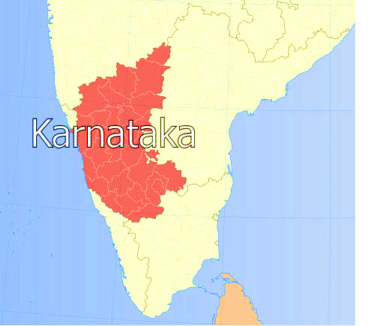
(Bildquelle: PlaneMad/Wikipedia. -- CC-by-sa)

(Bildquelle: PlaneMad/Wikipedia. -- CC-by-sa)
Zitierweise / cite as:
Hodson, Thomas: An elementary grammar of the Kannada, or Canarese language. --24. Syntax of Pronouns (§§ 204 - 216). -- Fassung vom 2011-08-26. -- URL: http://www.payer.de/hodson/hodson24.htm
First published as: Hodson, Thomas: An elementary grammar of the Kannada, or Canarese language ; in which every word used in the examples is translated, and the pronunciation is given in English characters. -- 2. ed. -- Bangalore : Wesleyan Mission Press, 1864. -- 128 p. ; 23 cm.
First time published here: 2011-08-26
Revisions:
©opyright: Public domain
This text is part of the section Sanskrit und Indien of Tüpfli's Global Village Library
If you don't get the diacritics displayed, install a Unicode font like Tahoma.
204. The crude state of pronouns is sometimes used for the nominative case; as,
205. Relation or possession is expressed by adding pronouns of the third person to the genitive of nouns and pronouns; as,
206. The plurals ನಾವು nāvu, we, and ನೀವು nīvu, ye, are very commonly used in the singular, when a person of respectability speaks of himself, or to an equal or superior; as,
207. The singular ನಿನು ninu, Thou, is disrespectful except when addressing inferiors.
208. In addressing persons of very superior rank, the reciprocal pronoun ತಾವು tāvu, themselves is used for the second person singular; as,
209. The singular ಅವನು avanu, he, and ಅವಳು avaḷu, she, are used when speaking of an equal or inferior.
The plural ಅವರು avaru, they, is used as an honorific singular when speaking of a superior.
210. ಆತನು ātanu, he, ಆಕೆಯು ākeyu, she, with their proximates, ಈತನು ītanu, he, ಈಕೆಯು īkeyu, she, are used of an equal or superior when respect is intended.
211. ತಾನು tānu, himself, herself, itself, is used with reference to a preceding nominative of the third person, expressed or understood; as,
In the last two examples the nominative is understood.
212. The plural ತಾವು tāvu, themselves, is used as a second person singular, in showing the highest respect; and is equivalent to "your honor," "your Lordship," &c.; as,
213. The singular ಯಾವನು yāvanu, and ಯಾವಳು yāvaḷu, are seldom used alone. The plural form ಯಾರು yāru, who, is also used for the singular of the masculine and feminine genders; as,
ಯಾರು yāru, is used also with the singular neuter in the expression
214. The crude form ಯಾವ yāva, is used with all the genders, and with both numbers; as,
215. When two or more pronouns of different persons are used together in a sentence, if one of them be in the First person, the verb and pronoun which refer to them must be of the first person plural; as,
216. If the nominative be of the Second and Third persons, the verb and pronoun which refer to them must be in the second person plural; as,
ಏನು ēnu, is frequently compounded with ಅದು adu, that, as ಏನದು ēnadu, and ಅದೇನು adēnu, what is that?
- With the interjection ಓ ō, affixed it is used as a common exclamation; thus
- When ಏನೋ ēnō, is uttered doubtingly in a reply to a question, it means, I don't know; I cannot say; it may be so, or it may not be so; as,
- Followed by ಆದರೂ ādarū, it means any thing whatsoever, something or other; as,
ಏನು ēnu folloowed by a negative, denotes nothing, not even the least thing.
To 25. Syntax of Verbs (§§ 217 - 222)